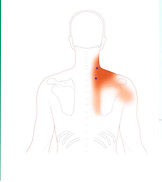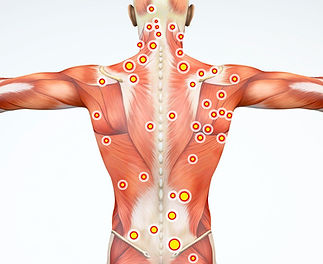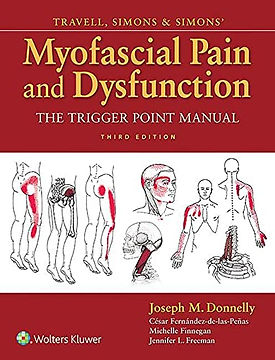History of Trigger Point
The study of muscular pain can be traced to the 15th century. Many terms have been proposed to describe muscle related pain. The most currently acceptable terms are myofascial pain and myofascial trigger points. Dr. Janet Travell, MD (1901-1997), an American medical doctor and the personal rheumatologist of US president John F. Kennedy, was the first to propose the term myofascial trigger point " in 1942. In 1960 Dr. Travell teamed up with Dr. David G. Simons, MD (1922-2010) to further explore the realm of trigger points and myofascial pain syndrome. In 1983, Simons and Travell published their work entitled "Myofascial Pain and Dysfunction - The Trigger Point Manual". This book was a breakthrough in the world of rheumatology, orthopedics and physiotherapy. It changed the understanding and treatment approach towards chronic pain. Since 1983, thousands of physiotherapists, doctors, chiropractors, massage therapists and other health professionals worldwide have applied trigger point therapy in their practice.
Area of Pain
About Janet G Travell, Founder of Myofascial Trigger Point Knowledge in the USA
Pain does not always mean you need surgery or medical intervention! Trigger Points, taught banded areas in muscle tissue, within the muscles are 90% the cause of soft tissue pain. So knowing about these pesky areas can bring all of us great relief. Trigger Point Therapy has a easy to follow road map developed in the 1950’s and 60’s by a pioneering doctor named Janet Travell. She was the first White House Physician, serving for President John F Kennedy then for Lyndon B Johnson. Travell is credited with helping Kennedy get out of his debilitating pain caused by a accident aboard the PT 109 submarine many years before his presidency. Using her techniques, Kennedy was able to stop using his crutch under his arm, and was able to run for the office of President. Travell served in the White House, until a few months before Kennedy was shot. She went back to working on her research into Trigger Points.
Just because we have pain or sensation in a particular area DOES NOT warrant a diagnosis of something we cannot view without MRI or X-ray. Even in the presence of degeneration in a joint or bones, that does not PROVE that is what is causing the pain. 90% of pain outside true pathology (like cancer or liver disease) comes from trigger points in muscles. Often just a few treatments using our Myofascial Trigger Point Therapy Treatment Protocol, people have a HUGE reduction in their pain and have improved strength and function of a given area of the body. Here are some common areas of pain, and a commonly used words to describe them, and some suggestions on how to get rid of this pain.
How can I describe my pain?
Different categories are used when describing or attempting to gather information about pain. These include:
-
Location, Site: where the pain is felt(ie Head, Neck, Shoulder, Shoulder Blade, Low Back, Glute, Buttock etc)
-
Intensity: how severe the pain is (ie Most pain scales use numbers from 0 to 10).
-
Frequency: how often the pain occurs (ie morning, night time)
-
Quality: the type of pain (ie. Deep, Ache, Dull, Sharp, tender, shooting etc.)
-
Duration: how long the pain lasts when it occurs
-
Pattern: what causes the pain and what improves it
-
Movement: what movement causes the pain
Dull pain is often chronic, lasting a few days, months, or more. Commonly, dull pain results from an old injury or a chronic condition. If you have a new, dull pain that doesn’t improve in two to three weeks, bring it to your doctor’s attention.



Q & A
Q. Do I need to see my doctor before I start treatment?
A. A physician's referral is not required. However, one is suggested to rule out other pathology causing your condition. In some cases, a therapist may require a physician referral to ensure no serious underlying medical condition needs to be addressed.
Q. How many sessions will it take to resolve my condition?
A. Since every condition is different, the frequency and duration of treatment may vary. The length of time you have been in pain, the severity of your pain, the number of body parts in pain, and your overall physical health affect how long treatment lasts. A person will usually achieve a noticeable reduction within 2-3 visits. Often the first visit gives significant relief. Being active in your treatment will help you recover more quickly.
Q. How can I help my treatment be more effective?
A. Your therapist will identify certain activities in your life that exacerbate your pain condition. We call these "perpetuating factors". These areas must be addressed to achieve lasting pain relief. These factors include posture, ergonomics, sleep and nutrition, among others. As part of your treatment program, your therapist will help you develop solutions to these perpetuating factors.
Q. Is Myofascial Trigger Point Therapy Painful?
A. Trigger points are rather sensitive by definition. During the treatment of myofascial pain, pressure is applied to trigger points. You are always in control of how much pressure you can tolerate. Patients usually describe it as "good pain." In most cases, a pain scale of 0-10 is used (0= no pain, 10= intolerable pain. ) We recommend pressure in a 5-7 pain range. You should let your therapist know if they are applying more pressure than you can handle. Communication with the therapist is very important because the proper amount of pressure differs for everyone and may differ in different areas of your body. Most people will also find it true that after a few treatments, the same amount of pressure will not hurt as much. This indicates that the treatment is working.
Q. Is trigger point therapy performed with a full body massage?
A. Not usually. Even though some certified trigger point therapists are certified massage therapists, they usually differentiate between trigger point therapy and a massage session. Some massage therapists will work on a trigger point when they find one but usually do not provide their patients with our comprehensive treatment protocol.
Q. Do I have to disrobe for a trigger point therapy appointment?
A. Myofascial Trigger Point Therapists need easy access to the areas needing treatment. Depending on the treated area, you can choose to disrobe or wear undergarments or a swimsuit. You may also choose to wear loose-fitting clothing and adjust your clothing to make your skin accessible for treatment. A typical trigger point therapy session will have your body in various treatment and stretch positions. It may have you standing and walking so the therapist can assess your posture and gait.
Q. Is there anything I can do to treat my pain?
A. Yes. Your trigger point therapist can teach you self-treatment techniques. You can use your hands, or your therapist may recommend treatment tools to assist you. Your therapist can guide you to appropriate educational materials.
Q & A
Neuromuscular technique requires extensive training and knowledge of the fascial connective tissue system; nervous, skeletal, and other major systems; and how they interact. Although neuromuscular therapy therapists will vary in their approach to the technique, a neuromuscular therapy session will generally include the following components:
• Assessment of the client’s condition to develop a strategy for pain management with massage therapy.
• Manual massage therapy using neuromuscular therapy and trigger-point techniques.
• Stretching and strengthening training to rehabilitate clients within the scope of massage.
• Collaborating with other healthcare professionals to assist in the client’s rehabilitation process.
• Educating clients about their bodies and teaching them how to alter behaviors that result in or trigger pain.
There are four elements associated with the hands-on aspect of neuromuscular therapy. Those include assessment, positional release, palpation skills, and PNF stretching.
Finding Massage Therapist near me
To ensure that you find a qualified massage therapist who meets your needs, it is advisable to follow these steps:
-
Seek a referral from a trusted healthcare provider.
-
Look up recognized databases, such as
-
Evaluate the therapist's qualifications, experience, and training.
-
Confirm that the therapist is open to collaborating with other healthcare professionals, especially if you are undergoing treatment for a medical condition.
-
Ensure the therapist is aware of any health conditions or concerns you may have and is experienced in treating them.
-
Determine if your health insurance covers the type of massage therapy you need and if there are any restrictions.
-
Ensure good communication between you, the massage therapist, and your healthcare team to ensure that all treatments align.
How many massage therapy sessions do you think I'll need?
There are no standard guidelines for the number of massages you can get. Massages for pain & injury are typically more frequent, while massages for pampering, maintenance, or relaxation purposes can occur less often. You may book your session whenever you need it.
Is it covered by health insurance?
I do not accept insurance at this time, however, I am able to provide an itemized bill with my NPI Number so you can submit it for reimbursement.
If you have a health savings account (HSA), or Flexible Spending Account (FSA) you may be able to use it to cover massage costs if it qualifies as medically necessary.
Health insurance may provide coverage for massages that are medically necessary or prescribed by your health provider. But even when health insurance covers massage, there may be a limit or maximum amount payable during a policy term.
Before getting a massage, check with your insurer to determine whether it is covered. If it’s not covered as a massage, find out whether there is coverage for physiotherapy from chiropractors or other related specialists.








